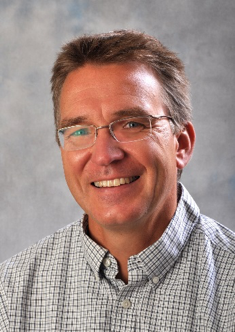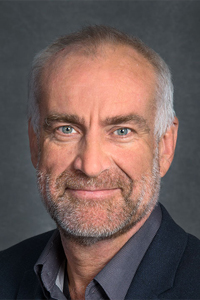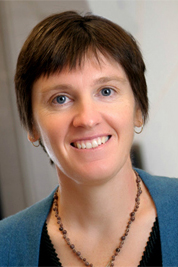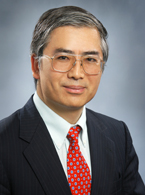Plenary Speakers for InterPore 2018
 |
Dr. Uwe Beuscher Global Modeling & Simulation Team Leader W.L. Gore and Associates, Inc., Industrial Produces Division |
||
Title:
Comparison of liquid particle filtration performance to porous media characterization
Abstract:
This lecture will provide an introduction into liquid particle filtration with microporous media and the correlation between removal efficiency and measured porous media structural parameters. Actual filtration experiments are tedious, can take a long time, are destructive, and depend to a large extend on the application. A characterization technique, which should be simpler, faster, and non-destructive and that provides an estimate of the expected filtration behavior gives great benefits. One critical parameter that influences the various particle capture mechanisms and their effectiveness over the life of the filter is the effective pore size distribution of the filter medium. In the filtration industry, this pore size distribution is often determined using capillary flow porometry, in which a wetting fluid is expelled from the porous structure using increasing gas pressure. The resulting data is represented by a gas flow vs. pressure curve, which can easily be converted into a pore size distribution by assuming a simple morphology for the porous structure. The relationship of this pore size estimate to filtration observations is mostly qualitative but lacks a good quantitative correlation due to a variety of factors. Experimental observations and model calculations for both filtration and porometry experiments illustrate the difficulty for finding a quantitative correlation between these two observations and will present a challenge for future research.
Bio:
Dr. Uwe Beuscher is a Technical Leader at W.L. Gore & Associates, Inc., the world leader in fluoropolymer materials for a wide variety of applications. Best known for the Gore-Tex® brand of apparel, W.L. Gore & Associates has developed thousands of unique consumer, industrial, electronic, medial and surgical products as well as materials for a wide variety of filtration and separation applications. Dr. Beuscher received his Diplom-Engineer degree in Mechanical Engineering from RWTH Aachen (Germany) and his Ph.D in Chemical Engineering from Clemson University. After joining W.L. Gore & Associates, Dr. Beuscher contributed to developments in a wide variety of separation applications including adsorption, catalysis, chromatography, polymer fuel cells, gas-liquid contactors, barrier materials, gas separation, liquid purification, and advanced microfiltration. Currently, Dr. Beuscher is leading the Gore Mercury Control System Team, which explores novel ways to remove Mercury and SO2 from flue gases and waste gas streams. Dr. Beuscher has authored or co-authored more than thirty technical papers, book chapters, and presentations. He has served on various advisory boards and as the president of the North American Membrane Society (NAMS).
 |
Dr. Jens Birkholzer Senior Scientist Lawrence Berkeley National Laboratory |
||
Title:
Cross-Cutting Subsurface Challenges: Insights from Dedicated Subsurface Energy Field Observatories
Abstract:
Subsurface resources currently supply over 80% of the United States’ energy needs. Within and beyond the U.S., they have enormous importance to economy, jobs, and energy security. A large fraction of these energy needs is currently provided by fossil fuels which when consumed using traditional methods release long-stored carbon into the atmosphere, with disruptive climatic effects. The transition to a large-scale U.S. clean energy future is expected to take decades, and may take longer in many other parts of the world. New scientific discoveries and technological advances must enable smarter, cleaner, and more efficient and environmentally responsible use of subsurface resources. This presentation first discusses selected cross-cutting challenges that currently limit efficient and environmentally responsible utilization of the subsurface. With cross-cutting challenges, we mean those that are similarly associated with a variety of subsurface energy applications, such as CO2 sequestration, unconventional hydrocarbon extraction, enhanced geothermal systems, nuclear waste disposal, and subsurface energy storage. The talk then moves on to the important role that geosciences field observatories can play in this context, allowing for focused in situ studies under controlled conditions at well-characterized locations, over long time periods. Several existing and planned examples of deep geoscience observatories are presented and discussed, addressing a range of R&D challenges in several subsurface energy applications.
Bio:
Jens Birkholzer is an internationally recognized expert in subsurface energy applications and environmental impact assessment. He is a Senior Scientist at the Lawrence Berkeley National Laboratory (LBNL) in Berkeley, California, and currently serves as the Director for the Energy Geosciences Division (EGD) at LBNL. He received his Ph.D. in water resources, hydrology, and soil science from Aachen University of Technology in Germany in 1994. Jens joined LBNL in 1994, left for a management position in his native Germany in 1999, and eventually returned to LBNL in 2001. He has over 400 scientific publications, about 125 of which are in peer-reviewed journals, in addition to numerous research reports. He serves as the Associate Editor of the International Journal of Greenhouse Gas Control (IJGGC) and is also on the Board of Editorial Policy Advisors for the Journal of Geomechanics for Energy and Environment (GETE). Jens leads the international DECOVALEX Project as its Chairman, is a Fellow of the Geological Society of America, and serves as a Senior Fellow of the California Council on Science and Technology.
 |
Prof. Sarah Codd Mechanical Engineering, Montana State University |
||
Title:
Magnetic Resonance Studies of Transport in Porous Media (with Prof. Joseph D. Seymour)
Abstract:
Magnetic resonance (MR) techniques allow characterization of porous materials on the ~10 mm imaging scale. However, more importantly, within this spatial resolution molecular level properties such as nuclear magnetic relaxation and translational molecular diffusion can provide nanometer scale molecular dynamic information. This allows measurements in porous media over a hierarchy of length and times scales from the pore to the system scales. An introduction to the MR techniques and results from a range of porous systems with environmental, geophysical and industrial relevance will be presented.
The measurement of the interplay between scale dependent hydrodynamic dispersion and structure in model biofouled porous media - relevant to subsurface processes and bioreactors, and polymer foams – relevant for applications such as air filtration, will be overviewed. Recent data on the spatial mapping of scalar temperature and concentration fields transported by advection and diffusion in porous media provides the means to correlate scalar transport and the direct measurement of the velocity field. The MR approach can use both fluorine and hydrogen nuclei for independently measuring particle and pore space transport. Packed beds of phase change materials allow temperature mapping using the hydrogen signal of the particles and velocity mapping of fluorinated fluid dynamics. While novel gel particles containing fluorinated compounds allow oxygen concentration mapping in biofilm impacted porous media with pore fluid water velocity mapped from the hydrogen signal. Advances in low field MR tools have allowed the development of down-the-borehole tools for field studies. Growth of a biofilm or biomineralization by bacteria can impact the MR signal and theses low field MR tools can monitor these processes in the subsurface.
Bio:
Sarah Codd is co-director of the Montana State University Magnetic Resonance (MR) Lab and a Professor in the Department of Mechanical and Industrial Engineering. She currently holds the MSU Women in Science Distinguished Professorship. She received her PhD in Physics from the University of Kent at Canterbury in the UK in 1996. She held several Post-Doc positions as a FORST Fellow at Massey University, New Zealand, a Humboldt Fellow at the University of Ulm, Germany, and at New Mexico Resonance, Albuquerque, which in combination provided her with the background necessary to launch a research program focused on applications of NMR and MRI to complex fluid and materials systems. She has been at Montana State University in Bozeman since 2001.
 |
Prof. Chunshan Song Energy Institute, Departments of Energy & Mineral Engineering, and of Chemical Engineering, The Pennsylvania State University |
||
Title:
Novel Nano-porous Materials for Energy and Environmental Applications
Abstract:
Significant advances have been made in our research over the past decade in designing novel nano-porous materials for energy and environmental applications including CO2 capture and conversion to chemicals and fuels as well as shape-selective synthesis of chemicals and catalytic decomposition of environmental pollutants. For CO2 capture, industrial processes use liquid amine solvents which are energy intensive and costly. We have developed the new concept of solid “molecular basket” sorbents (MBS) for CO2 capture which is more energy efficient. MBS consists of functional polymers immobilized in nano-porous materials (such as SBA-15, TUD-1, MCF, and Carbon). Nano-porous MBS materials have been successfully designed and applied in capture and separation of CO2 and H2S from various industrial gases [1,2]. The CO2 MBS has also been recently demonstrated successfully through pilot plant-scale tests. For CO2 conversion, new nano-structured materials have shown great potential. Examples are given for catalytic conversion of CO2 through dry reforming to syngas and for catalytic hydrogenation using nano-structured metal catalysts. More recently, we have shown that hollow nano-structured zeolite crystals have great potential as multi-functional catalysts and nano-confined materials for energy and environmental applications including CO2 conversion and pollutants decomposition [3,4]. Hollow Silicalite-1 and hollow ZSM-5 crystals with silicon-rich exterior surface were prepared by a “dissolution-recrystallization” strategy in tetrapropylammonium hydroxide solution. More interestingly, hollow ZSM-5 single crystals with double shells were successfully prepared via layer-by-layer technique followed with dissolution - recrystallization strategy. Furthermore, hollow ZSM-5 encapsulating iron and carbon nanotubes were successfully synthesized. The hollow ZSM-5 exhibits excellent acid catalysis with enhanced shape selectivity.
Bio:
Dr. Chunshan Song is a Distinguished Professor of Fuel Science and Professor of Chemical Engineering, Director of the EMS Energy Institute and Associate Director of Institutes of Energy and the Environment at the Pennsylvania State University, University Park. His research interests include heterogeneous catalysis, CO2 capture and conversion, synthesis and applications of nano-structured materials, energy conversion and chemicals synthesis, and adsorption for ultra-clean clean fuels. He received BS (1982) in Chemical Engineering from Dalian University of Technology, China, and MS (1986) and PhD (1989) in Applied Chemistry from Osaka University, Japan. He worked at Research Center of Osaka Gas Company in Japan before joining Penn State in the US in Nov 1989. Currently he also directs the international Joint Center for Energy Research between Penn State and Dalian University of Technology where he serves as QianRen Professor (type B). He has over 330 refereed publications and delivered over 60 plenary and keynote lectures at international conferences and over 270 invited lectures worldwide. He served as Chair of American Chemical Society’s Fuel Division and Petroleum Division, Co-chair for the 24th North American Catalysis Society Biennial Meeting and Chair of the 12th International Conference on Carbon Dioxide Utilization. He is the Editor for Advances in Catalysis and serves on advisory boards for 15 research journals in catalysis, CO2 utilization, energy and fuels, and chemical engineering. He has received many awards such as Henry H. Storch Award in Fuel Science and Distinguished Researcher Award in Petroleum Chemistry from American Chemical Society, Fellow of American Chemical Society, Distinguished Fulbright Scholar Award from US-UK, Chang Jiang Scholar Award and QianRen Award from China, Herman Pines Award from Catalysis Club of Chicago, Catalysis Club of Philadelphia Award, AIST and NEDO Fellowship Awards from Japan, and within Penn State, the Faculty Scholar Medal, Distinguished University Professor, Wilson Award for Outstanding Research, and Faculty Mentoring Award. According to Elsevier and Shanghai Ranking 2016, he is one of “The Most Cited Researchers” worldwide in “Chemical Engineering” and in “Energy Science and Engineering”.


